Human Resource Management in Healthcare: Key Roles and Functions
VerifiedAdded on 2023/01/23
|9
|1899
|96
Report
AI Summary
This report provides a comprehensive overview of Human Resource Management (HRM) in the healthcare field. It begins by defining HRM and highlighting its critical importance, then delves into the key roles HRM plays, including talent acquisition, compensation and remuneration, performance appraisal, training and development, and diversity management. The report then outlines the core functions of HRM, such as planning, organizing, directing, and controlling, emphasizing the significance of planning in furthering the healthcare field. Furthermore, the report explores the role of HRM in an organization's strategic plan, covering team building, employee motivation, employer-employee relationship management, conflict management, and job design. The report concludes by emphasizing the essential nature of HRM in any organization and the need to enhance its effectiveness and efficiency, supported by relevant references.
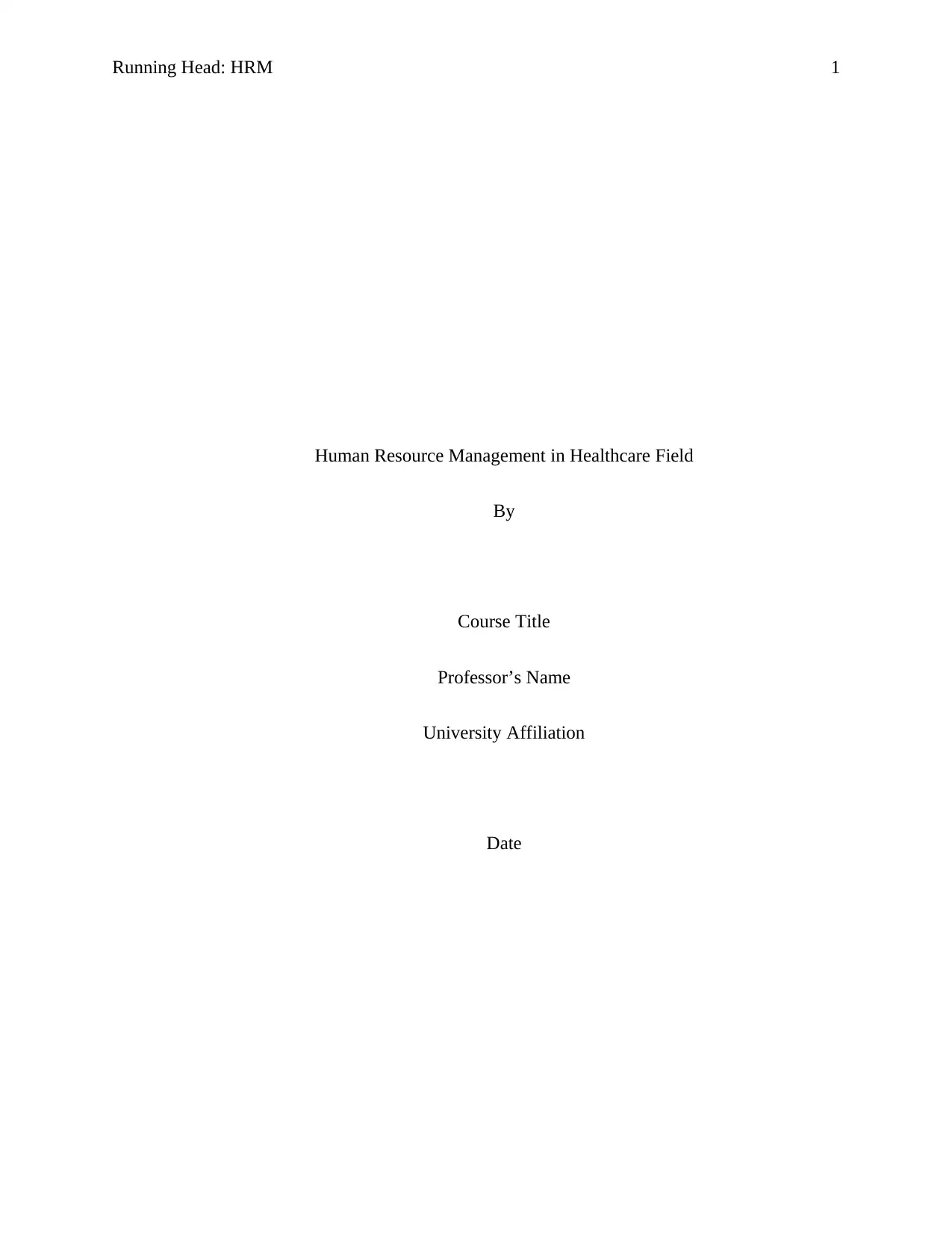
Running Head: HRM 1
Human Resource Management in Healthcare Field
By
Course Title
Professor’s Name
University Affiliation
Date
Human Resource Management in Healthcare Field
By
Course Title
Professor’s Name
University Affiliation
Date
Paraphrase This Document
Need a fresh take? Get an instant paraphrase of this document with our AI Paraphraser
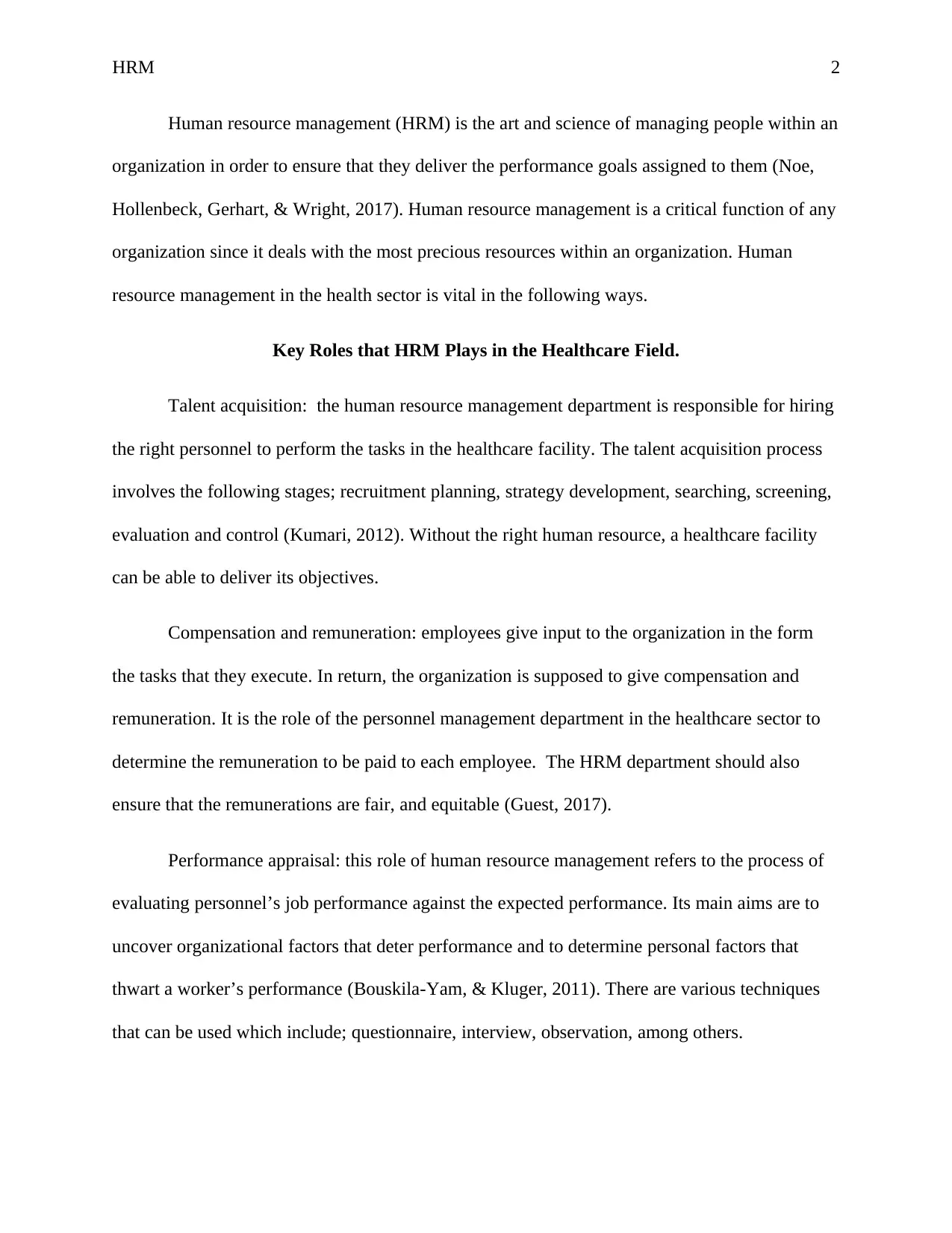
HRM 2
Human resource management (HRM) is the art and science of managing people within an
organization in order to ensure that they deliver the performance goals assigned to them (Noe,
Hollenbeck, Gerhart, & Wright, 2017). Human resource management is a critical function of any
organization since it deals with the most precious resources within an organization. Human
resource management in the health sector is vital in the following ways.
Key Roles that HRM Plays in the Healthcare Field.
Talent acquisition: the human resource management department is responsible for hiring
the right personnel to perform the tasks in the healthcare facility. The talent acquisition process
involves the following stages; recruitment planning, strategy development, searching, screening,
evaluation and control (Kumari, 2012). Without the right human resource, a healthcare facility
can be able to deliver its objectives.
Compensation and remuneration: employees give input to the organization in the form
the tasks that they execute. In return, the organization is supposed to give compensation and
remuneration. It is the role of the personnel management department in the healthcare sector to
determine the remuneration to be paid to each employee. The HRM department should also
ensure that the remunerations are fair, and equitable (Guest, 2017).
Performance appraisal: this role of human resource management refers to the process of
evaluating personnel’s job performance against the expected performance. Its main aims are to
uncover organizational factors that deter performance and to determine personal factors that
thwart a worker’s performance (Bouskila-Yam, & Kluger, 2011). There are various techniques
that can be used which include; questionnaire, interview, observation, among others.
Human resource management (HRM) is the art and science of managing people within an
organization in order to ensure that they deliver the performance goals assigned to them (Noe,
Hollenbeck, Gerhart, & Wright, 2017). Human resource management is a critical function of any
organization since it deals with the most precious resources within an organization. Human
resource management in the health sector is vital in the following ways.
Key Roles that HRM Plays in the Healthcare Field.
Talent acquisition: the human resource management department is responsible for hiring
the right personnel to perform the tasks in the healthcare facility. The talent acquisition process
involves the following stages; recruitment planning, strategy development, searching, screening,
evaluation and control (Kumari, 2012). Without the right human resource, a healthcare facility
can be able to deliver its objectives.
Compensation and remuneration: employees give input to the organization in the form
the tasks that they execute. In return, the organization is supposed to give compensation and
remuneration. It is the role of the personnel management department in the healthcare sector to
determine the remuneration to be paid to each employee. The HRM department should also
ensure that the remunerations are fair, and equitable (Guest, 2017).
Performance appraisal: this role of human resource management refers to the process of
evaluating personnel’s job performance against the expected performance. Its main aims are to
uncover organizational factors that deter performance and to determine personal factors that
thwart a worker’s performance (Bouskila-Yam, & Kluger, 2011). There are various techniques
that can be used which include; questionnaire, interview, observation, among others.
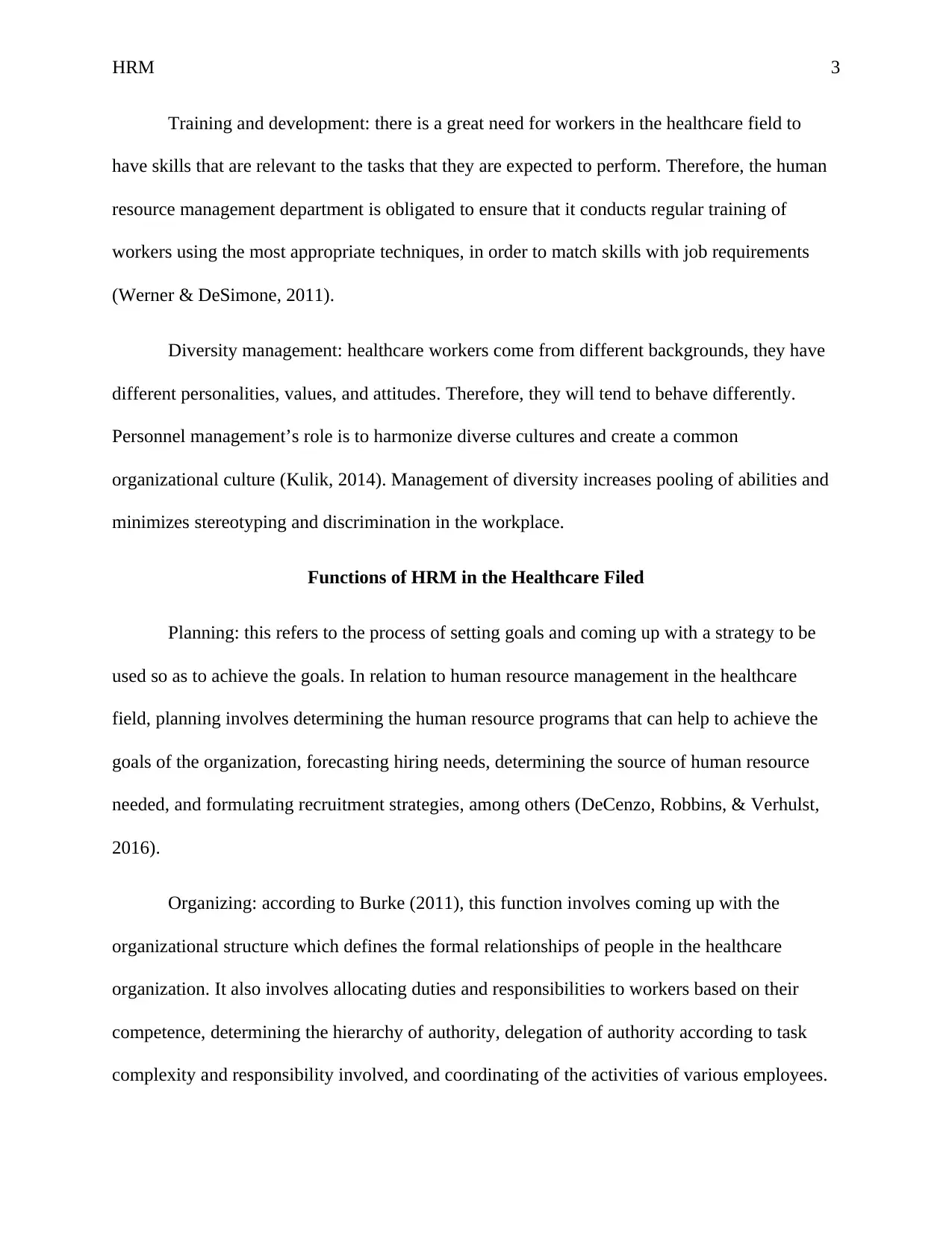
HRM 3
Training and development: there is a great need for workers in the healthcare field to
have skills that are relevant to the tasks that they are expected to perform. Therefore, the human
resource management department is obligated to ensure that it conducts regular training of
workers using the most appropriate techniques, in order to match skills with job requirements
(Werner & DeSimone, 2011).
Diversity management: healthcare workers come from different backgrounds, they have
different personalities, values, and attitudes. Therefore, they will tend to behave differently.
Personnel management’s role is to harmonize diverse cultures and create a common
organizational culture (Kulik, 2014). Management of diversity increases pooling of abilities and
minimizes stereotyping and discrimination in the workplace.
Functions of HRM in the Healthcare Filed
Planning: this refers to the process of setting goals and coming up with a strategy to be
used so as to achieve the goals. In relation to human resource management in the healthcare
field, planning involves determining the human resource programs that can help to achieve the
goals of the organization, forecasting hiring needs, determining the source of human resource
needed, and formulating recruitment strategies, among others (DeCenzo, Robbins, & Verhulst,
2016).
Organizing: according to Burke (2011), this function involves coming up with the
organizational structure which defines the formal relationships of people in the healthcare
organization. It also involves allocating duties and responsibilities to workers based on their
competence, determining the hierarchy of authority, delegation of authority according to task
complexity and responsibility involved, and coordinating of the activities of various employees.
Training and development: there is a great need for workers in the healthcare field to
have skills that are relevant to the tasks that they are expected to perform. Therefore, the human
resource management department is obligated to ensure that it conducts regular training of
workers using the most appropriate techniques, in order to match skills with job requirements
(Werner & DeSimone, 2011).
Diversity management: healthcare workers come from different backgrounds, they have
different personalities, values, and attitudes. Therefore, they will tend to behave differently.
Personnel management’s role is to harmonize diverse cultures and create a common
organizational culture (Kulik, 2014). Management of diversity increases pooling of abilities and
minimizes stereotyping and discrimination in the workplace.
Functions of HRM in the Healthcare Filed
Planning: this refers to the process of setting goals and coming up with a strategy to be
used so as to achieve the goals. In relation to human resource management in the healthcare
field, planning involves determining the human resource programs that can help to achieve the
goals of the organization, forecasting hiring needs, determining the source of human resource
needed, and formulating recruitment strategies, among others (DeCenzo, Robbins, & Verhulst,
2016).
Organizing: according to Burke (2011), this function involves coming up with the
organizational structure which defines the formal relationships of people in the healthcare
organization. It also involves allocating duties and responsibilities to workers based on their
competence, determining the hierarchy of authority, delegation of authority according to task
complexity and responsibility involved, and coordinating of the activities of various employees.
⊘ This is a preview!⊘
Do you want full access?
Subscribe today to unlock all pages.

Trusted by 1+ million students worldwide
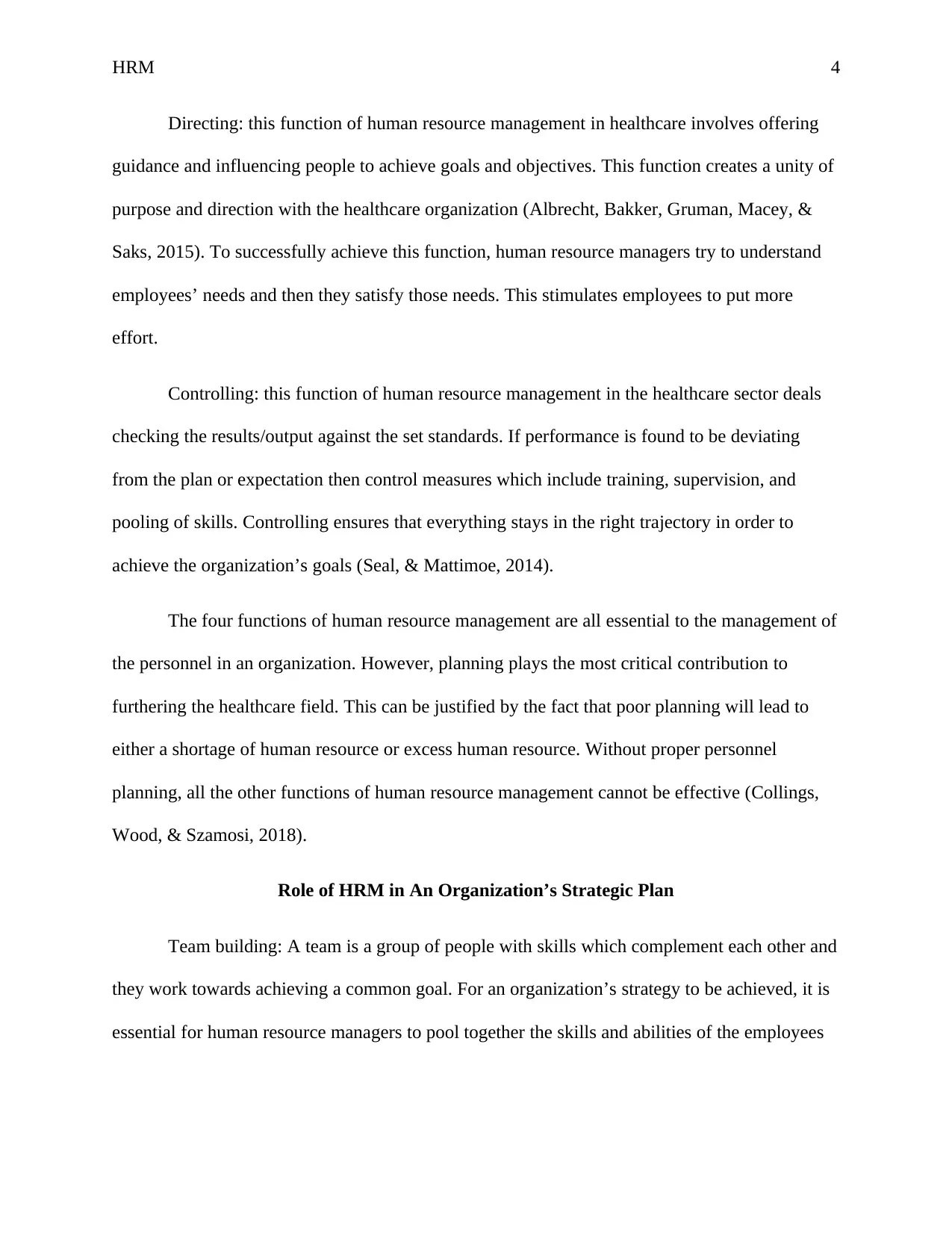
HRM 4
Directing: this function of human resource management in healthcare involves offering
guidance and influencing people to achieve goals and objectives. This function creates a unity of
purpose and direction with the healthcare organization (Albrecht, Bakker, Gruman, Macey, &
Saks, 2015). To successfully achieve this function, human resource managers try to understand
employees’ needs and then they satisfy those needs. This stimulates employees to put more
effort.
Controlling: this function of human resource management in the healthcare sector deals
checking the results/output against the set standards. If performance is found to be deviating
from the plan or expectation then control measures which include training, supervision, and
pooling of skills. Controlling ensures that everything stays in the right trajectory in order to
achieve the organization’s goals (Seal, & Mattimoe, 2014).
The four functions of human resource management are all essential to the management of
the personnel in an organization. However, planning plays the most critical contribution to
furthering the healthcare field. This can be justified by the fact that poor planning will lead to
either a shortage of human resource or excess human resource. Without proper personnel
planning, all the other functions of human resource management cannot be effective (Collings,
Wood, & Szamosi, 2018).
Role of HRM in An Organization’s Strategic Plan
Team building: A team is a group of people with skills which complement each other and
they work towards achieving a common goal. For an organization’s strategy to be achieved, it is
essential for human resource managers to pool together the skills and abilities of the employees
Directing: this function of human resource management in healthcare involves offering
guidance and influencing people to achieve goals and objectives. This function creates a unity of
purpose and direction with the healthcare organization (Albrecht, Bakker, Gruman, Macey, &
Saks, 2015). To successfully achieve this function, human resource managers try to understand
employees’ needs and then they satisfy those needs. This stimulates employees to put more
effort.
Controlling: this function of human resource management in the healthcare sector deals
checking the results/output against the set standards. If performance is found to be deviating
from the plan or expectation then control measures which include training, supervision, and
pooling of skills. Controlling ensures that everything stays in the right trajectory in order to
achieve the organization’s goals (Seal, & Mattimoe, 2014).
The four functions of human resource management are all essential to the management of
the personnel in an organization. However, planning plays the most critical contribution to
furthering the healthcare field. This can be justified by the fact that poor planning will lead to
either a shortage of human resource or excess human resource. Without proper personnel
planning, all the other functions of human resource management cannot be effective (Collings,
Wood, & Szamosi, 2018).
Role of HRM in An Organization’s Strategic Plan
Team building: A team is a group of people with skills which complement each other and
they work towards achieving a common goal. For an organization’s strategy to be achieved, it is
essential for human resource managers to pool together the skills and abilities of the employees
Paraphrase This Document
Need a fresh take? Get an instant paraphrase of this document with our AI Paraphraser
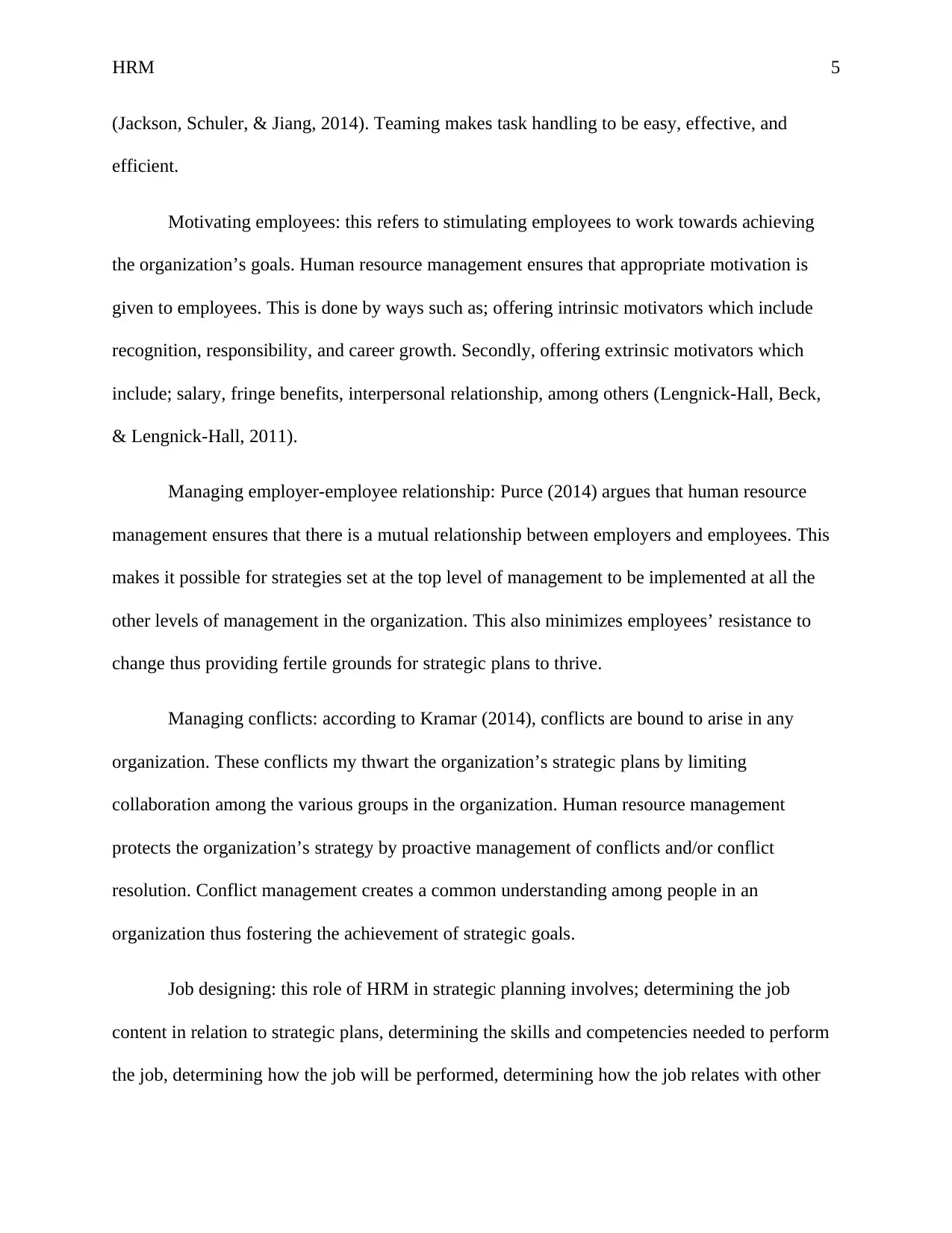
HRM 5
(Jackson, Schuler, & Jiang, 2014). Teaming makes task handling to be easy, effective, and
efficient.
Motivating employees: this refers to stimulating employees to work towards achieving
the organization’s goals. Human resource management ensures that appropriate motivation is
given to employees. This is done by ways such as; offering intrinsic motivators which include
recognition, responsibility, and career growth. Secondly, offering extrinsic motivators which
include; salary, fringe benefits, interpersonal relationship, among others (Lengnick-Hall, Beck,
& Lengnick-Hall, 2011).
Managing employer-employee relationship: Purce (2014) argues that human resource
management ensures that there is a mutual relationship between employers and employees. This
makes it possible for strategies set at the top level of management to be implemented at all the
other levels of management in the organization. This also minimizes employees’ resistance to
change thus providing fertile grounds for strategic plans to thrive.
Managing conflicts: according to Kramar (2014), conflicts are bound to arise in any
organization. These conflicts my thwart the organization’s strategic plans by limiting
collaboration among the various groups in the organization. Human resource management
protects the organization’s strategy by proactive management of conflicts and/or conflict
resolution. Conflict management creates a common understanding among people in an
organization thus fostering the achievement of strategic goals.
Job designing: this role of HRM in strategic planning involves; determining the job
content in relation to strategic plans, determining the skills and competencies needed to perform
the job, determining how the job will be performed, determining how the job relates with other
(Jackson, Schuler, & Jiang, 2014). Teaming makes task handling to be easy, effective, and
efficient.
Motivating employees: this refers to stimulating employees to work towards achieving
the organization’s goals. Human resource management ensures that appropriate motivation is
given to employees. This is done by ways such as; offering intrinsic motivators which include
recognition, responsibility, and career growth. Secondly, offering extrinsic motivators which
include; salary, fringe benefits, interpersonal relationship, among others (Lengnick-Hall, Beck,
& Lengnick-Hall, 2011).
Managing employer-employee relationship: Purce (2014) argues that human resource
management ensures that there is a mutual relationship between employers and employees. This
makes it possible for strategies set at the top level of management to be implemented at all the
other levels of management in the organization. This also minimizes employees’ resistance to
change thus providing fertile grounds for strategic plans to thrive.
Managing conflicts: according to Kramar (2014), conflicts are bound to arise in any
organization. These conflicts my thwart the organization’s strategic plans by limiting
collaboration among the various groups in the organization. Human resource management
protects the organization’s strategy by proactive management of conflicts and/or conflict
resolution. Conflict management creates a common understanding among people in an
organization thus fostering the achievement of strategic goals.
Job designing: this role of HRM in strategic planning involves; determining the job
content in relation to strategic plans, determining the skills and competencies needed to perform
the job, determining how the job will be performed, determining how the job relates with other

HRM 6
jobs in the organization, and determining the remuneration for the job. Proper job designing
ensures consistency of the job with the strategic plans of the organization (Buller & McEvoy,
2012).
Based on the above discussion, it is crystal clear that human resource management is very
essential in any organization. HRM should, therefore, be enhanced so that it can be more
effective and efficient.
jobs in the organization, and determining the remuneration for the job. Proper job designing
ensures consistency of the job with the strategic plans of the organization (Buller & McEvoy,
2012).
Based on the above discussion, it is crystal clear that human resource management is very
essential in any organization. HRM should, therefore, be enhanced so that it can be more
effective and efficient.
⊘ This is a preview!⊘
Do you want full access?
Subscribe today to unlock all pages.

Trusted by 1+ million students worldwide
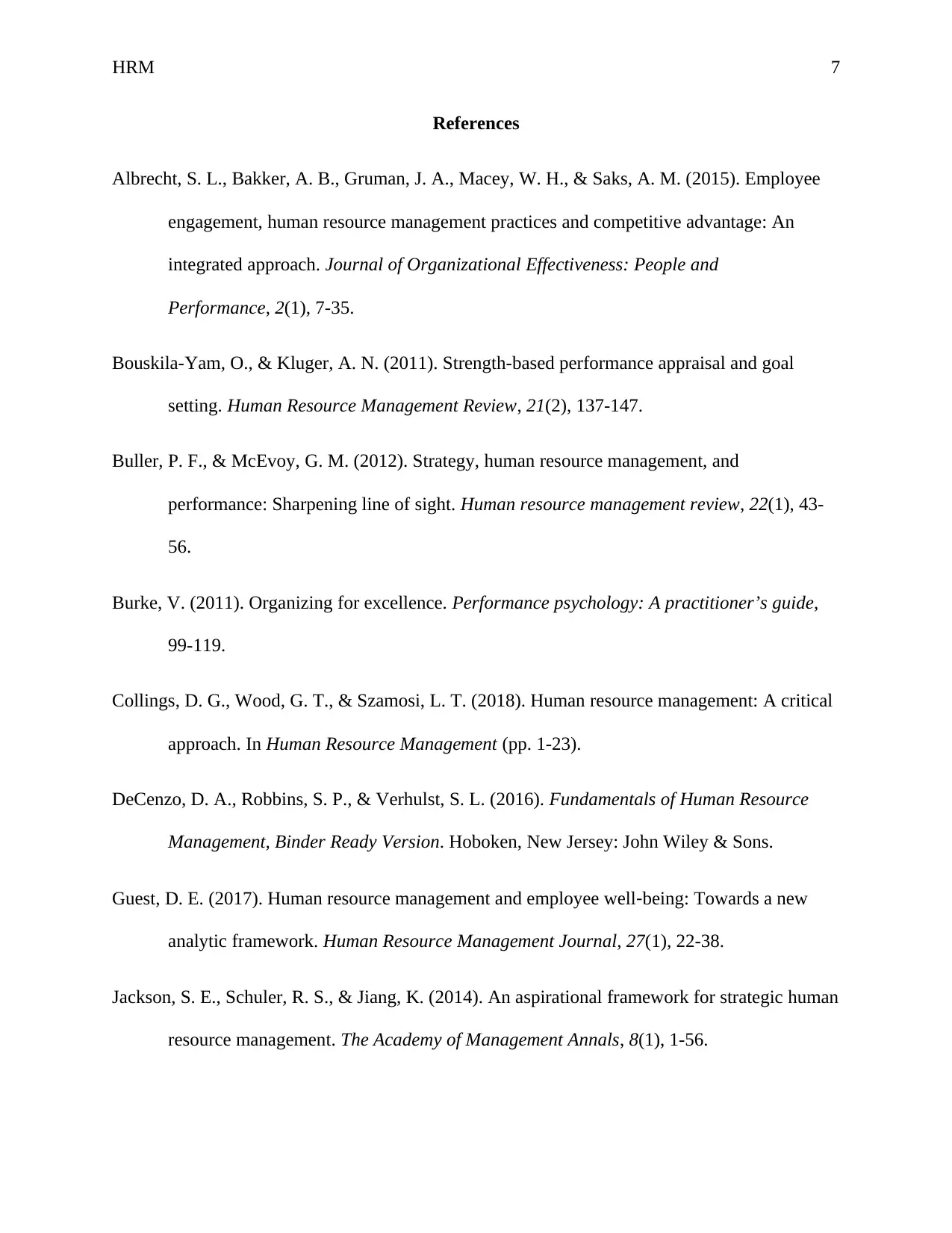
HRM 7
References
Albrecht, S. L., Bakker, A. B., Gruman, J. A., Macey, W. H., & Saks, A. M. (2015). Employee
engagement, human resource management practices and competitive advantage: An
integrated approach. Journal of Organizational Effectiveness: People and
Performance, 2(1), 7-35.
Bouskila-Yam, O., & Kluger, A. N. (2011). Strength-based performance appraisal and goal
setting. Human Resource Management Review, 21(2), 137-147.
Buller, P. F., & McEvoy, G. M. (2012). Strategy, human resource management, and
performance: Sharpening line of sight. Human resource management review, 22(1), 43-
56.
Burke, V. (2011). Organizing for excellence. Performance psychology: A practitioner’s guide,
99-119.
Collings, D. G., Wood, G. T., & Szamosi, L. T. (2018). Human resource management: A critical
approach. In Human Resource Management (pp. 1-23).
DeCenzo, D. A., Robbins, S. P., & Verhulst, S. L. (2016). Fundamentals of Human Resource
Management, Binder Ready Version. Hoboken, New Jersey: John Wiley & Sons.
Guest, D. E. (2017). Human resource management and employee well‐being: Towards a new
analytic framework. Human Resource Management Journal, 27(1), 22-38.
Jackson, S. E., Schuler, R. S., & Jiang, K. (2014). An aspirational framework for strategic human
resource management. The Academy of Management Annals, 8(1), 1-56.
References
Albrecht, S. L., Bakker, A. B., Gruman, J. A., Macey, W. H., & Saks, A. M. (2015). Employee
engagement, human resource management practices and competitive advantage: An
integrated approach. Journal of Organizational Effectiveness: People and
Performance, 2(1), 7-35.
Bouskila-Yam, O., & Kluger, A. N. (2011). Strength-based performance appraisal and goal
setting. Human Resource Management Review, 21(2), 137-147.
Buller, P. F., & McEvoy, G. M. (2012). Strategy, human resource management, and
performance: Sharpening line of sight. Human resource management review, 22(1), 43-
56.
Burke, V. (2011). Organizing for excellence. Performance psychology: A practitioner’s guide,
99-119.
Collings, D. G., Wood, G. T., & Szamosi, L. T. (2018). Human resource management: A critical
approach. In Human Resource Management (pp. 1-23).
DeCenzo, D. A., Robbins, S. P., & Verhulst, S. L. (2016). Fundamentals of Human Resource
Management, Binder Ready Version. Hoboken, New Jersey: John Wiley & Sons.
Guest, D. E. (2017). Human resource management and employee well‐being: Towards a new
analytic framework. Human Resource Management Journal, 27(1), 22-38.
Jackson, S. E., Schuler, R. S., & Jiang, K. (2014). An aspirational framework for strategic human
resource management. The Academy of Management Annals, 8(1), 1-56.
Paraphrase This Document
Need a fresh take? Get an instant paraphrase of this document with our AI Paraphraser
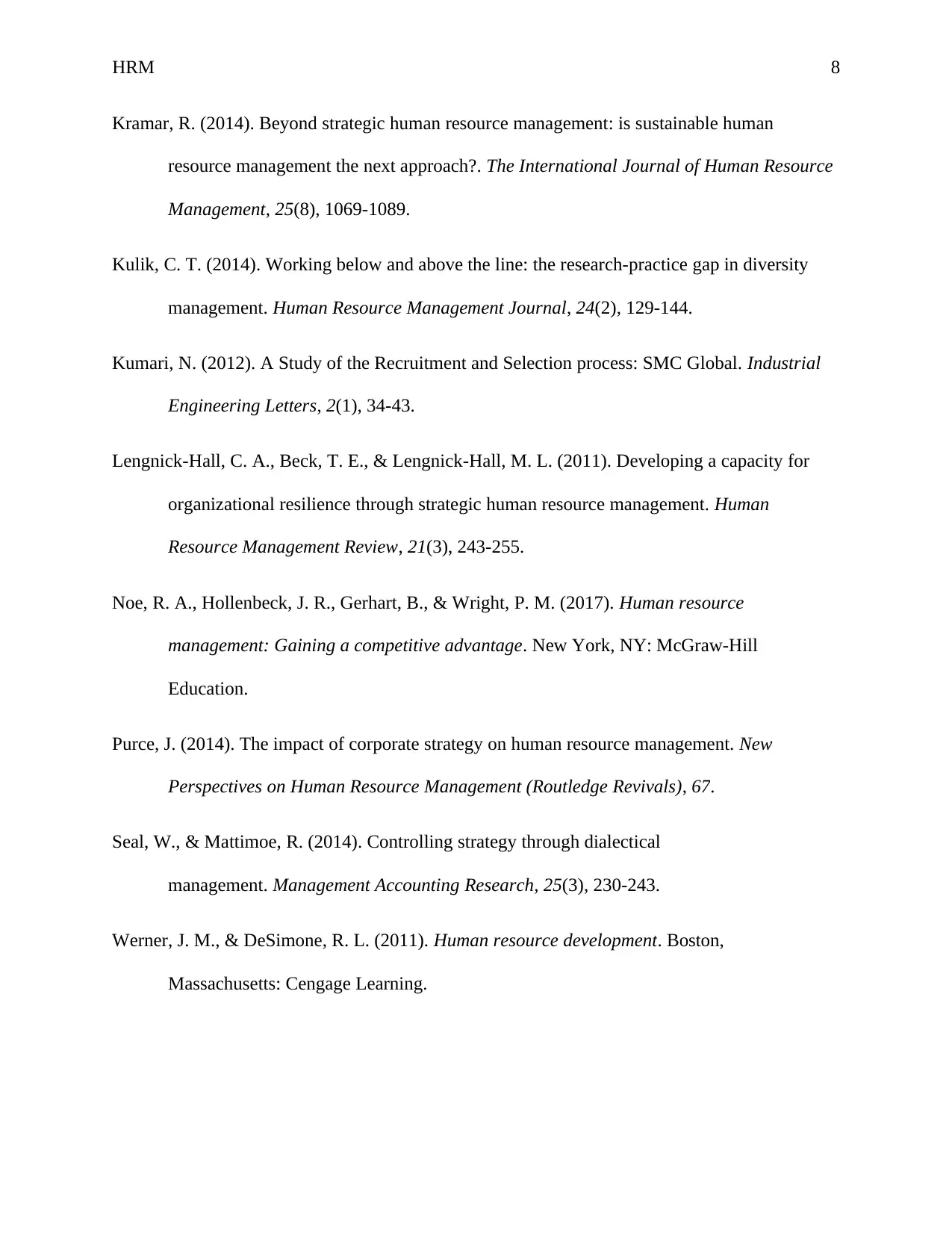
HRM 8
Kramar, R. (2014). Beyond strategic human resource management: is sustainable human
resource management the next approach?. The International Journal of Human Resource
Management, 25(8), 1069-1089.
Kulik, C. T. (2014). Working below and above the line: the research-practice gap in diversity
management. Human Resource Management Journal, 24(2), 129-144.
Kumari, N. (2012). A Study of the Recruitment and Selection process: SMC Global. Industrial
Engineering Letters, 2(1), 34-43.
Lengnick-Hall, C. A., Beck, T. E., & Lengnick-Hall, M. L. (2011). Developing a capacity for
organizational resilience through strategic human resource management. Human
Resource Management Review, 21(3), 243-255.
Noe, R. A., Hollenbeck, J. R., Gerhart, B., & Wright, P. M. (2017). Human resource
management: Gaining a competitive advantage. New York, NY: McGraw-Hill
Education.
Purce, J. (2014). The impact of corporate strategy on human resource management. New
Perspectives on Human Resource Management (Routledge Revivals), 67.
Seal, W., & Mattimoe, R. (2014). Controlling strategy through dialectical
management. Management Accounting Research, 25(3), 230-243.
Werner, J. M., & DeSimone, R. L. (2011). Human resource development. Boston,
Massachusetts: Cengage Learning.
Kramar, R. (2014). Beyond strategic human resource management: is sustainable human
resource management the next approach?. The International Journal of Human Resource
Management, 25(8), 1069-1089.
Kulik, C. T. (2014). Working below and above the line: the research-practice gap in diversity
management. Human Resource Management Journal, 24(2), 129-144.
Kumari, N. (2012). A Study of the Recruitment and Selection process: SMC Global. Industrial
Engineering Letters, 2(1), 34-43.
Lengnick-Hall, C. A., Beck, T. E., & Lengnick-Hall, M. L. (2011). Developing a capacity for
organizational resilience through strategic human resource management. Human
Resource Management Review, 21(3), 243-255.
Noe, R. A., Hollenbeck, J. R., Gerhart, B., & Wright, P. M. (2017). Human resource
management: Gaining a competitive advantage. New York, NY: McGraw-Hill
Education.
Purce, J. (2014). The impact of corporate strategy on human resource management. New
Perspectives on Human Resource Management (Routledge Revivals), 67.
Seal, W., & Mattimoe, R. (2014). Controlling strategy through dialectical
management. Management Accounting Research, 25(3), 230-243.
Werner, J. M., & DeSimone, R. L. (2011). Human resource development. Boston,
Massachusetts: Cengage Learning.

HRM 9
⊘ This is a preview!⊘
Do you want full access?
Subscribe today to unlock all pages.

Trusted by 1+ million students worldwide
1 out of 9
Related Documents
Your All-in-One AI-Powered Toolkit for Academic Success.
+13062052269
info@desklib.com
Available 24*7 on WhatsApp / Email
![[object Object]](/_next/static/media/star-bottom.7253800d.svg)
Unlock your academic potential
Copyright © 2020–2025 A2Z Services. All Rights Reserved. Developed and managed by ZUCOL.





